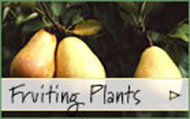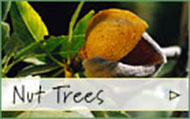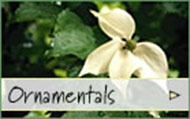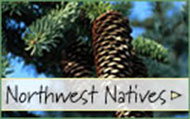NSNSAUS
|
|
|
|
NSNSBLU
|
|
 |
| BLUE ELDERBERRY (Sambucus caerulea) |
| A fast growing, hardy shrub with large clusters of tiny white flowers followed by huge quantities of easily harvested blue fruit. Blue Elderberry fruits can be used for jams, wine, and preserves. Very beneficial northwest native plant for pollinators; attracting bees, butterflies and hummingbirds. Prefers sun. Can have a multi-stemmed habit and grows to about 30 ft. Zone 3-8. |
|
|
NSNSECAS
|
|
|
|
NSNSEVHUC
|
|
 |
| EVERGREEN HUCKLEBERRY (Vaccinium ovatum) |
| A shade tolerant, evergreen shrub native to the coastal northwest. Edible shiny black, blueberry-like fruit in fall. Cut Evergreen Huckleberry branches are popularly used in floral arrangements. Needs acidic soils. Grows to about 2-3 ft. in sun and 6 ft. in shade. Zone 7-9. |
|
|
NSNSNAT
|
|
 |
| NATIVE STAR EVERGREEN HUCKLEBERRY (Vaccinium ovatum) |
| Upright, compact form, with year-round glossy green small leaves and dark burgundy berries in fall. Spring new growth is burgundy. Will grow sun or shade; more berries in sun, but will need supplemental watering. Grows to about 6 ft. tall. Native Star Huckleberry selected for fruiting and ornamental qualities. Zone 7-9. |
|
|
NSNSORE
|
|
 |
| OREGON GRAPE (Mahonia aquifolium) |
| Pretty evergreen understory shrub, 3 - 5 ft. tall. Native to the Pacific Northwest, Oregon Grape will naturalize itself unless if the suckers are removed. Bright yellow spring flowers with very tart blue berries. Leaves commonly used in floral arrangements. Glossy green serrated leaves reminiscent of holly leaves turn reddish purple over winter. Zone 5-8. |
|
|
NSNSSAL
|
|
 |
| SALAL (Gaultheria shallon) |
| Understory native shrub with edible black fruit growing in clusters. Blueberry sized berries are a traditional staple food of Northwest Coastal Indians. Can be eaten fresh, cooked, or dried. Salal makes an excellent jelly. Stems with large evergreen leaves used in floral arrangements. In sun, will be about 2 ft. tall; in shade up to 6 ft. Zone 7-9. |
|
|
NSNVSWORD
|
|
 |
| SWORD FERN (Polystichum munitum) |
| Large leaved evergreen fronds are up to 4 ft in height and width. The Sword Fern is native to cool shady forests in the maritime northwest, from Northern California to Canada. Zone 7-8. |
|
|
NSNSJEW
|
|
 |
| CASCADE JEWEL HUCKLEBERRY (Vaccinium ovatum) |
| Cascade Jewel is an evergreen huckleberry that is especially productive of good- sized black berries. At maturity it has an upright compact form 3.5 feet high by 3 feet wide. It produces dark red new leaves in the spring which turn green in the summer. Patented OSU selection. Zone 7-9. |
|
|
NSNSKIN
|
|
 |
| KING EDWARD VII FLOWERING CURRANT (Ribes sanguineum) |
| A select later blooming variety of red flowering currant. Dense form, more compact growing than others of the species. Spectacular crimson flowers in early spring. Blue edible berries. King Edward VII is a selection of the northwest native Ribes sanguineum currant. Zone 6-8.
CAN NOT SHIP TO NC/MA |
|
|
NSNSRED
|
|
 |
| RED OSIER DOGWOOD (Cornus sericea) |
| Dense, flat-top clusters of white blossoms in spring which later drape down and become tipped with white berries. Dark green leaves change to burgundy in autumn and shine scarlet in sunlight. Amazing wildlife value as a food source to a range of birds, beneficial insects and mammals. An important larval host to the Spring Azure Butterfly. Red stems are brilliant against a snowy background in winter. Fast growth rate is great in mass planting landscapes, hedges or use as a winter interest specimen. Plant 3-4' apart in a hedge. Full sun to partial shade. Zone 3-7. |
|
|
NSNSBLGOO
|
|
 |
| BLACK GOOSEBERRY (Ribes divaricatum) |
A native found in forests, woodlands and the coasts of the Pacific Northwest. Tasty blueberry-sized sweet fruit that turns purplish-black when ripe. Clusters of dangling small flowers visited by hummingbirds and butterflies. Wildlife graze on the berries.
Coastal Black Gooseberry is a thorny shrub to 5 ft. at maturity. Grows in sun or partial shade. Disease resistant. Zone 4-8.
RESTRICTIONS: GOOSEBERRY PLANTS CAN NOT BE SHIPPED TO MA, NC |
|
|

 Click here to view items for:
Winter / Spring (Jan-June)
Summer (July-Oct)
Fall (Nov-Dec)
Click here to view items for:
Winter / Spring (Jan-June)
Summer (July-Oct)
Fall (Nov-Dec)



















